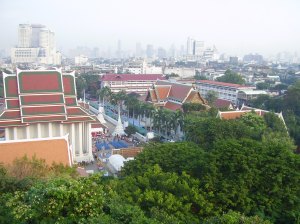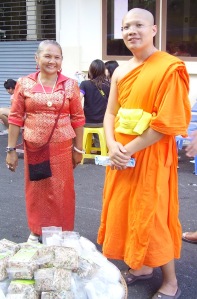From the nearest canal boat pier to me, you can get to Pratunam in the city centre and there you can pick up another boat to Saphan Panfah which is near Khao San Road. A short walk from that pier is a lovely temple called Wat Saket. This one is even worth visiting when you get ‘templed out’, something which can happen very quickly with me. It is also known as the Temple of the Golden Mount and, at one time, was Bangkok’s best viewpoint. I think it is still one of the best. The mount is man-made and was started between 1840 and 1842, under the reign of King Rama III. It was abandoned when the structure started to give way and was eventually completed by King Rama IV (I don’t know the exact completion date as all of the history books I have seen omit this salient fact) who put a stupa and an enclosed gallery around it at the top. However, they weren’t finished until the next reign, that of King Rama V and, again, no exact dates seem to be available.
A stupa, or chedi as it is called in Thailand, is essentially a ‘mound like structure containing Buddhist relics’. They date back to the time of the Buddha whose ashes were divided and buried under eight stupas with two further stupas encasing the urn and the embers. Each country in this region seems to have developed its own style of stupa but the golden mount does not have the usual design for Thailand. The Buddha relic in this stupa was given to the king of Thailand by the British.
The hill, or mount, represents the replica on earth of Mount Meru which is a sacred mountain in Hindu, Buddhist and Jain mythology and is believed to be the centre of all the physical, metaphysical and spiritual universes. Mount Meru is believed to be eighty thousand vojanas tall. The exact measure of the yojana is uncertain. Some accounts put it at about twenty four thousand feet, or approximately four and a half miles, but other accounts put it at about seven to nine miles. It also descends beneath the surface of the surrounding waters to a depth of eighty thousand vojanas, where it is thought to be founded upon the basal layer of Earth. Meru (which is sometimes called Sumeru just to confuse us) is often used as a simile for both size and stability in Buddhist texts. Mount Meru is said to be shaped like an hourglass, with a top and base of eighty thousand vojanas square, but narrowing in the middle (presumably at a height of forty thousand vojanas) to twenty thousand vojanas square. It is believed to be the polar center of a mandala-like complex of seas and mountains. The square base of Mount Meru is surrounded by a square moat-like ocean, which is in turn surrounded by a ring (or rather square) wall of mountains, which is in turn surrounded by a sea, each diminishing in width and height from the one closer to Meru. There are seven seas and seven surrounding mountain-walls, until one comes to the vast outer sea which forms most of the surface of the world, in which the known continents are merely small islands. The known world, which is located on the continent of Jambudvipa, is directly south of Meru. And the miracle is that I can tell you all that without ever having read a Terry Pratchet book.
Anyway, the top of the mount really is a good viewpoint and you only have to climb three hundred and eighteen steps to get up there. For me with my long legs, it was even less: just one hundred and fifty nine as I took the small steps two at a time. As recently as the 1960’s, it was one of Bangkok’s highest points. Inevitably, I suppose, the city is now full of skyscrapers and, as I write this, yet another ‘tallest building’ has been given the go ahead – something my non-technical mind finds quite scary in this sinking city.
The temple itself is the location for an important annual fair in November, finishing on Loy Kratong Day. I think it is a lovely place but that hasn’t always been the case. For instance, in 1897, a guy called Sommerville in his book ‘Siam on the Meinam from Gulf to Ayuthia’ described it as “one of the most offensive and horrible sights of Bangkok”. Apparently it was then used as a cremation ground for the poor and the destitute and Somerville was referring to the ashes of the human remains floating around, dogs chewing the bones, vultures in the trees and the corpses of prisoners that had been dumped there. Of this, he wrote: “One of the custodians quickly raised the body of the prisoner up in the box and with a sharp knife cut a number of strips of flesh from the arms and thighs and callously threw piece after piece to the more greedy birds, who eagerly crowded around”.
About a quarter of a century earlier though, another guy (Frank Vincent in ‘The Land of the White Elephant’) said of the view from here: “The general appearance of Bangkok is that of a large, primitive village, situated in and mostly concealed by a virgin forest of almost impenetrable density”. It must have been a lovely sight and is still definitely worth seeing.
The November temple fair is the biggest temple fair I have been to and all of the surrounding streets are taken over by it. It lasts for eight days and includes a daily candle lit procession up the mount. On the first day, a sacred red cloth is paraded round the base of the mount and then wrapped around the stupa. Rides, side-shows, market stalls, food stalls and more abound. I love these Thai fairs as they remind me of travelling funfairs back home when I was a boy but I’m pleased that I now seem to be old enough to resist going in to the freak show.

Making a sweet pastry that looks like a rolled up net, traditionally from the southern part of Thailand,
Anywhere in the world, food is usually an important part of a festival or a day out and Thailand is certainly no exception to that. The range of food stalls here is mind-blowing including many old fashioned ones which you won’t normally see any more. If you only ever go to one temple fair in Thailand, you should try and make this the one.








Leave a comment